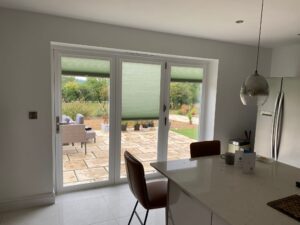How to Avoid Condensation & Mould on Your Windows
Your windows “cry” when warm, moist indoor air meets a cold pane and instantly cools.
The water vapour in that air turns into droplets, which run down the glass and soak into frames and sills. Left alone, that moisture creates the perfect environment for mould.
The solution isn’t a single gadget; it’s a simple routine that balances heat, humidity and airflow – without sacrificing your privacy or your love of shutters and blinds.
The quick morning reset
A short, sharp burst of fresh air each morning makes a big difference. Open the window slightly for five to ten minutes while the kettle’s on, then close it to keep the warmth in.
If you have shutters or blinds, keep them in place and angle the slats so warm room air can wash the glass. That gentle convection dries off overnight moisture and sends it outside instead of into your paintwork.
Keep the warmth steady
Rooms that bounce between toasty and chilly invite condensation because surfaces repeatedly drop below the dew point. Aim for a gentle, consistent temperature rather than “heating sprints.”
It feels more comfortable, protects your décor and actually helps your boiler work more efficiently. If long curtains or bulky window dressings trap heat against the glass, tuck them clear of radiators so you’re warming the room, not the back of your fabric.
Find the humidity sweet spot
Most homes feel healthiest at around 40–60% relative humidity. If you’re often above that range, you’ll notice misted panes and musty corners.
A small, inexpensive hygrometer will tell you where you stand.
When humidity creeps up – after cooking, showers or laundry – use targeted ventilation or run a dehumidifier for an hour to bring levels back down without chilling the whole house.
Cook without the clouds
Kitchens are steam factories, but you can keep the vapour under control. Use pan lids when boiling or simmering and switch on the extractor before you start. Let it run for fifteen to twenty minutes after cooking to clear the last of the moisture.
If you prefer to keep a roller blind down for privacy, leave a small gap at the top so warm air can drift up the glass and the fan can do its job.
Shower steam, sorted
Bathrooms produce short, intense bursts of humidity. Keep the door closed, open a small window or ensure the extractor is on, and let it run after you finish. If you have shutters, feather the louvres so air can move while you towel off.
With roller or Roman blinds, leave a top sliver open; that tiny path is enough to stop condensation clinging to the fabric or the pane.
Venting with shutters
Shutters and good ventilation can absolutely be friends. Angle the louvres upwards so warm air rises across the glass rather than being blocked by the slats.
If privacy is vital, open the upper section of tier-on-tier shutters and keep the lower tier closed. You’ll get a discreet airflow path, a clearer pane and a room that still feels cosy and contained.
Venting with venetian and faux-wood blinds
Venetians are brilliant for micro-venting. Tilt the slats so the leading edge faces the room and you’ll create a gentle upward wash of warm air over the pane.
Try not to press the blind tight against the glass; a modest stand-off encourages circulation, keeps the reveal drier and reduces the chance of mould forming along the bottom rail.
Venting with roller and Roman blinds
Rollers and Romans excel at privacy and insulation, but they can trap a cool air pocket. The fix is simple: raise the blind a few centimetres from the top during the day so warm air can slip behind it.
In kitchens and bathrooms, moisture-resistant fabrics or treated linings are worth the upgrade, as they resist mould spores and dry out faster after steamy moments.
Honeycomb and Duette shades done right
Cellular or Duette shades are champions for insulation, yet their very efficiency can create a cold layer against the glass. To avoid this, drop the shade as usual but leave a small gap at the top.
That opening encourages a convection loop: warm air rises behind the fabric, brushes the pane and returns to the room, keeping condensation in check without sacrificing the snug feel.
Trickle vents and the quiet win
If your frames have trickle vents, keep them open in winter. They allow a whisper of fresh air high in the room, which warms, rises and nudges stale, humid air out – especially effective when internal doors are ajar to create a gentle stack effect.
If you don’t have vents, stick to the daily “purge”: a brief, purposeful window-open moment that swaps damp air for dry.
Seal the leaks, not the house
Perished seals, gappy beads and draughty frames create cold spots where moisture loves to settle. Refreshing seals and neatly re-siliconing problem areas cuts down on chilly streaks without turning your home into a plastic-wrapped box.
You’re aiming for controlled ventilation, not random leaks that chill one corner and leave the rest stuffy.
Bedrooms: the sneaky hotspot
We breathe out a surprising amount of water overnight, so bedrooms are often the foggiest rooms at dawn.
Before bed, angle slats to encourage airflow and, if you have them, leave trickle vents open. In the morning, give the room a quick purge and let the glass clear.
Pull large wardrobes a few centimetres off external walls to prevent hidden cold patches and the tell-tale peppering of mould behind furniture.
Dealing with mould the right way
If mould appears, treat it promptly and safely. Wear gloves and a basic mask, then clean affected non-porous areas with a mould-specific remover or a mild diluted bleach solution, testing a small patch first.
Dry the area thoroughly and, once it’s bone-dry, consider a mould-inhibiting primer and paint for persistent zones. Most importantly, tackle the cause – excess humidity meeting a cold surface – so you don’t end up on a cleaning loop.
Smart upgrades that genuinely help
Quiet, humidity-sensing extractor fans remove the guesswork and run only when needed. Moisture-resistant shutters and blinds in wet rooms pay for themselves by resisting spores and wiping clean easily.
Thermal linings add comfort on chilly elevations, provided you maintain that small top or side gap for airflow. For stubborn north-facing panes, a seasonal window-insulation film can raise surface temperature just enough to tip the balance away from condensation.
The bottom line
Condensation and mould aren’t a winter inevitability. With steady warmth, sensible humidity and thoughtful venting – perfectly compatible with shutters and blinds – you can keep glass clear, frames healthy and rooms feeling fresh.
Feather the slats, crack a vent, run the extractor when life gets steamy and give each day that brief purge. Your windows, your paintwork and your lungs will all thank you.
Should you have any questions or would like more information about our product ranges, please don’t hesitate to contact the Fraser James Blinds team. Alternatively, you can also arrange a home visit at a time that works best for you.









